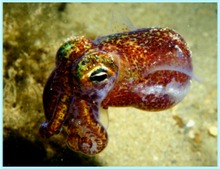| Euprymna scolopes | |
|---|---|

| |
| The Hawaiian bobtail squid, Euprymna scolopes, swimming in the water column off the south shore of Oahu | |
| Scientific classification | |
| Domain: | Eukaryota |
| Kingdom: | Animalia |
| Phylum: | Mollusca |
| Class: | Cephalopoda |
| Order: | Sepiida |
| Family: | Sepiolidae |
| Subfamily: | Sepiolinae |
| Genus: | Euprymna |
| Species: | E. scolopes
|
| Binomial name | |
| Euprymna scolopes | |
Euprymna scolopes, also known as the Hawaiian bobtail squid, is a species of bobtail squid in the family Sepiolidae native to the central Pacific Ocean, where it occurs in shallow coastal waters off the Hawaiian Islands and Midway Island.[3][4] The type specimen was collected off the Hawaiian Islands and is located at the National Museum of Natural History in Washington, D.C.[5]
Euprymna scolopes grows to 30 mm (1.2 in) in mantle length.[3] Hatchlings weigh 0.005 g (0.00018 oz) and mature in 80 days. Adults weigh up to 2.67 g (0.094 oz).[6]
In the wild, E. scolopes feeds on species of shrimp, including Halocaridina rubra, Palaemon debilis, and Palaemon pacificus.[7] In the laboratory, E. scolopes has been reared on a varied diet of animals, including mysids (Anisomysis sp.), brine shrimp (Artemia salina), mosquitofish (Gambusia affinis), prawns (Leander debilis), and octopuses (Octopus cyanea).[8]
The Hawaiian monk seal (Monachus schauinslandi) preys on E. scolopes in northwestern Hawaiian waters.[9]
On June 3, 2021, SpaceX CRS-22 launched E. scolopes, along with tardigrades, to the International Space Station. The squid were launched as hatchlings and will be studied to see if they can incorporate their symbiotic bacteria into their light organ while in space.[10]
- ^ Barratt, I.; Allcock, L. (2012). "Euprymna scolopes". The IUCN Red List of Threatened Species. 2012: e.T162598A925206. doi:10.2305/IUCN.UK.2012-1.RLTS.T162598A925206.en. Downloaded on 11 February 2018.
- ^ Julian Finn (2016). "Euprymna scolopes Berry, 1913". World Register of Marine Species. Flanders Marine Institute. Retrieved 11 February 2018.
- ^ a b Reid, A. & P. Jereb 2005. Family Sepiolidae. In: P. Jereb & C.F.E. Roper, eds. Cephalopods of the world. An annotated and illustrated catalogue of species known to date. Volume 1. Chambered nautiluses and sepioids (Nautilidae, Sepiidae, Sepiolidae, Sepiadariidae, Idiosepiidae and Spirulidae). FAO Species Catalogue for Fishery Purposes. No. 4, Vol. 1. Rome, FAO. pp. 153–203.
- ^ Countries' Exclusive Economic Zones with Euprymna scolopes Archived July 15, 2003, at the Wayback Machine
- ^ "Current Classification of Recent Cephalopoda" (PDF). Archived from the original (PDF) on 2006-01-01. Retrieved 2007-02-16.
- ^ Wood, J.B. & R.K. O'Dor 2000. "Do larger cephalopods live longer? Effects of temperature and phylogeny on interspecific comparisons of age and size at maturity" (PDF). Archived from the original (PDF) on December 14, 2004. (134 KB) Marine Biology 136(1): 91.
- ^ Shears, J. 1988. The Use of a Sand-coat in Relation to Feeding and Diel Activity in the Sepiolid Squid Euprymna scolopes. R.T. Hanlon (ed.) Malacologia 29(1): 121-133.
- ^ Boletzky, S.v. & R.T. Hanlon. 1983. A Review of the Laboratory Maintenance, Rearing and Culture of Cephalopod Molluscs. Memoirs of the National Museum of Victoria: Proceedings of the Workshop on the Biology and Resource Potential of Cephalopods, Melbourne, Australia, 9–13 March 1981, Roper, Clyde F.E., C.C. Lu and F.G. Hochberg, ed. 44: 147-187.
- ^ Goodman-Lowe, G.D. 1998. "Diet of the Hawaiian monk seal (Monachus schauinslandi) from the northwestern Hawaiian islands during 1991 and 1994" (PDF). Archived from the original (PDF) on May 7, 2005. (294 KB) Marine Biology 132: 535-546.
- ^ June 2021, Amy Thompson 01 (June 2021). "SpaceX will launch baby squid and tardigrades to the space station this week". Space.com. Retrieved 2021-06-24.
{{cite web}}: CS1 maint: numeric names: authors list (link)
